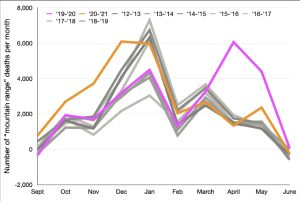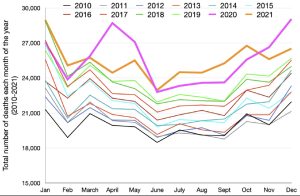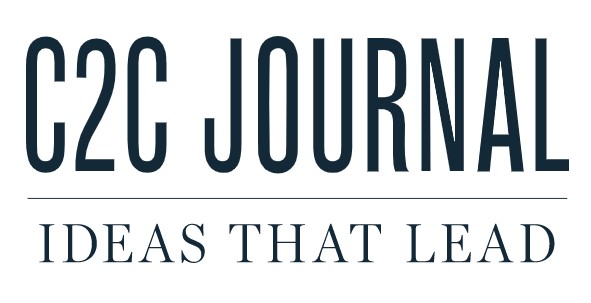The late U.S. president Ronald Reagan liked to say the nine scariest words were, “I’m from the government and I’m here to help.” Governments did a lot of “helping” during the pandemic, and some statistical analysis suggests results more frightening than any virus.
In January, Dr. Jim Mason released one of only four known evaluations of excess deaths in Canada during the pandemic. Dr. Mason’s qualifications include a PhD in experimental nuclear physics and decades of experience in statistical analysis, and his explosive findings were recently published in the C2C Journal.
Mason used monthly death counts from Statistics Canada, from 2010 through 2019, to predict what statistically normal ranges would have been for the pandemic years of 2020 and 2021.
The retiree who lives near Lakeland, Ontario, found most months under examination were “within, or very nearly so, the uncertainty ranges of the predicted values.” A few, however, proved exceptional. April and May 2020 – the months immediately after governments effectively declared medical martial law by imposing lockdowns – were “well above the predicted range” and November and December were “marginally above the predicted range.” July and August 2021 were a bit above the predicted range, and September and October were more so.

Regardless, the annual totals of 2019-20 and 2020-21 were within the 95 per cent confidence interval of expectations. Interestingly, Dr Mason found an equal rate of excessive deaths in 2012-13 and an even higher one in 2014-15 when life continued as usual. He postulated that these previous peaks were “likely due to severe strains of flu or inappropriately formulated flu shots.”
Based on excess deaths alone, Mason concluded, “government measures had little impact” but a different one focused on “particularly vulnerable demographics might have ameliorated or avoided the steep death toll of April – May 2020.”
To distinguish pandemic deaths from others, Mason looked to an analysis by UBC health professor Kimberlyn McGrail published in the Canadian Medical Association Journal in May 2022. Mason’s premise was that if total excess deaths exceeded COVID-19 deaths, that margin was directly or indirectly due to pandemic measures implemented by the government.

In March of 2020, U.S. President Donald Trump said notably that the government response to coronavirus should not “be worse than the problem itself.” What Mason observed from McGrail’s stats spanning March 14, 2020 to October 23, 2021, was that Canadian governments failed this standard.
B.C. had a notorious stretch in August of 2020 where genuine COVID-19 deaths were only 1 per million, but total excess deaths were 15 per million, suggesting government overreach could be responsible for 14 times as many deaths as the virus.
“In these situations, it is not unreasonable to state that the government’s response to the viral pandemic was worse than the virus itself,” Mason wrote.
“In several provinces, excess deaths are more than twice as great as Covid-19 deaths, suggesting that deaths caused by government measures exceeded the deaths caused by the virus.”
Excess death rates were highest in B.C., Alberta, and Saskatchewan, ranging from 10 to 11.4 per cent. But COVID-19 deaths represented just 22.2 per cent of excess deaths in B.C., 46.2 per cent in Alberta, and 47.2 per cent in Saskatchewan. So, if the virus wasn’t killing them, what was?
“In most provinces, government measures contributed to the excess death count. In plain language, the government response to Covid-19 got people killed,” Mason wrote.
One bizarre exception was Quebec. That province had almost twice the reported COVID-19 mortality rate of any other province, yet significantly fewer excess deaths.
“Quebec’s government measures were highly ineffective at curbing Covid-19 deaths but highly effective at avoiding deaths from other causes,” wrote Mason.
The Quebecois method failed to restrain the virus, but it did succeed in destroying people’s social lives. Starting January 9, 2021, the province had mandatory curfews from 8 pm to 5 am. Stores, salons, and museums reopened on February 8, but curfews persisted until May 28.
“That is one of the positive effects of the curfew, it reduces the incidents of ending up in other people’s homes,” said public health chief Horacio Arruda in February.
How strangely auspicious: the province most eager to euthanize its inhabitants subjected its entire population to house arrest to perpetuate lives of anti-social misery.
Manitoba also had fewer excess mortalities. However, it was also the province that banned in-store sales of non-essential items from November 20, 2020 until early February or mid-March, 2021, depending on provincial location. They killed businesses to save lives, and still had more than 6 per cent excess deaths.
If the government banned all vehicles, it could stop all deaths cased by vehicular accidents. But what kind of lives would we have? Would it really be worth the transportation inconvenience?
Analyses such as those made by Mason and McGrail deserve attention but are unlikely to receive it. When it comes to this virus , both government and media parroted some narratives and forbade others. Now that those who said, “trust the science” find the science against them, why would they ever admit it?
Lee Harding is a research associate at the Frontier Centre for Public Policy.
Read the full C2C Report:
Did the Virus or Governments Kill More Canadians? A Statistical Analysis of Excess Deaths during the Pandemic by Jim Mason, C2C Journal, January 31, 2023



